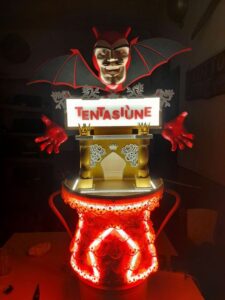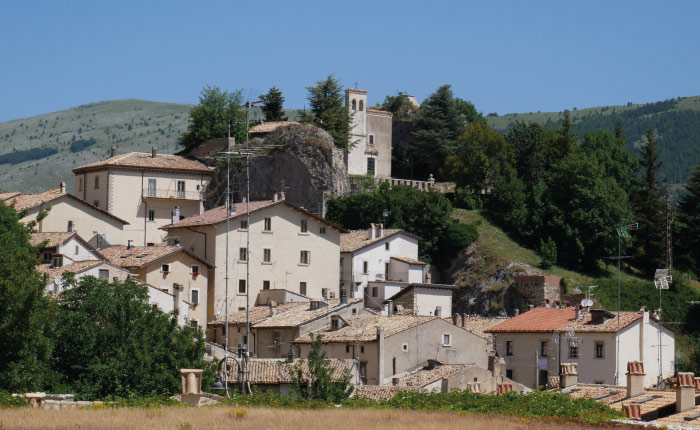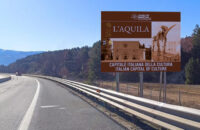Saint Anthony Abbot is a figure venerated in many regions of Italy. This saint is known as the protector of animals and for his ability to resist demonic temptations, qualities that make him a symbol of strength and endurance.
In Abruzzo, the cult of St. Anthony Abbot is particularly heartfelt and widespread. The feast is marked by countless sacred and ritual events and that often include the “Temptations of St. Anthony,” a performance that takes place in many Abruzzo municipalities on January 16 and 17. Another characteristic aspect of Abruzzo’s celebrations is the lighting of purifying fires, which symbolize the saint’s fight against evil and the seasonal renewal of nature.
Fara Filiorum Petri
In Fara Filiorum Petri, a town located in the Val di Foro at the foot of Mount Maiella, the feast of St. Anthony Abbot is characterized by the “farchie,” large cylindrical bundles of reeds tied with red willow branches. These are raised and set on fire on January 16, creating a fire show that illuminates the night sky. The tradition dates back to a miracle attributed to the saint, who is said to have saved the town from invading French troops in 1799. All the details of this tradition are in the article we dedicated to it.
Collelongo
In Collelongo, between Fucino and the territory of the Abruzzo, Lazio and Molise National Park, celebrations of St. Anthony Abbot take place mainly on the night of January 16-17. This tradition, which has been renewed for more than four centuries, sees the participation of thousands of people who pour into the village streets to celebrate with songs and fires from dusk to dawn.
 It starts with the Cuttora, the beating heart of the feast of St. Anthony Abbot in Collelongo. The term comes from the large pot in which corn is cooked, which after a long boiling process turns into “ciceròcche.” Lit with juniper wood, it forms the hearth around which Collelongongo residents and pilgrims gather, welcomed into private homes transformed for the occasion into places of hospitality and celebration.
It starts with the Cuttora, the beating heart of the feast of St. Anthony Abbot in Collelongo. The term comes from the large pot in which corn is cooked, which after a long boiling process turns into “ciceròcche.” Lit with juniper wood, it forms the hearth around which Collelongongo residents and pilgrims gather, welcomed into private homes transformed for the occasion into places of hospitality and celebration.
Fire is another central element of the festival, a symbol of purification and rebirth. In Collelongo, the “torcione” is a work of art made of wood, crafted by skilled shipwrights and hoisted in the main squares, while children participate with “torcette,” unique flashlights made by twisting wooden saplings, which they defibrate and transform into symbols of light and devotion.
At dawn on the 17th, maidens dressed in the traditional clothes of Collelongo come out of the main houses of the village, carrying on their heads the “rescagnata,” that is, decorated, conca, and make their way to the Santa Maria Nuova Church, where the ancient statue of St. Anthony is located. From here they will parade back through the village for the competition on the most original and best-made conca and the most beautifully worn dress.
The feast of St. Anthony the Abbot in Collelongo is an interweaving of tradition, community and spirituality, where sharing is the watchword and fire marks the transition from winter to spring in a celebration that unites past and present.
Villavallelonga
A few kilometers away, Villavallelonga celebrates St. Anthony with the traditional “Panarda”dinner, grand banquets organized by the village families. The feast lasts throughout the night amid fires and refreshment places. On Jan. 17, St. Anthony’s Day, the festivities continue with the procession, blessing of animals and parade of floats marking the official opening of the Carnival consisting of the competition between “ugly” (dressed in black, with cowbells hanging from their bodies) and “beautiful” (dressed in white, with hats adorned with ribbons and colorful flowers).
Other towns that celebrate St. Anthony Abbot in Abruzzo are San Valentino in Abruzzo Citeriore (PE), where the “sbandimende,” a kind of public auction of foodstuffs, takes place and a performance of the Temptations is staged, Ateleta (AQ) with a historically themed masked procession parade amid fires, procession and blessing of animals. Also characteristic are the masquerade questua in Pescocostanzo (AQ ) amid fires and balloons, the street concert with the “cow alarm” a traditional percussion instrument similar to the charrasco in Pescosansonesco (PE), the Sagra dei granati e della porchetta in Cerchio (AQ), the boiling of must in the square in Ovindoli (AQ) or the sagne di Sant’Antonio in Scanno (AQ) seasoned with blessed ricotta cheese and distributed after the Holy Mass.

Rome and environs
Also in Rome, every January 17, in front of the church of Sant’Eusebio, between Via Napoleone III and Piazza Vittorio, a traditional service is renewed: the blessing of animals. Today the rite is celebrated in a reduced form and involves pets, such as dogs, cats and canaries. But in past centuries the ceremony involved a grandiose apparatus, with a procession of animals ranging from oxen to donkeys, from farm animals to the horses of the nobles’ carriages. Traditionally it took place in the church of St. Anthony Abbot and only in the last century was it diverted, for traffic reasons, to St. Eusebius. Right in front of the convent of Sant’Eusebio and during the blessing of the animals Vittorio Caprioli set one of the scenes of “Paris, O Dear,” a 1962 film written and starring Franca Valeri.
Caprarola
Not far from Rome, one of the main places for St. Anthony Abbot celebrations is Caprarola. Here, celebrations take place from January 15 to 21 and include the blessing and lighting of St. Anthony’s fire, as well as the celebration of the Eucharist and the blessing of bread.
Velletri
In Velletri, celebrations for St. Anthony Abbot are held Jan. 17-20. The University of Mulattieri e Carrettieri organizes events that include the blessing of the banner, parades of harnessed horses and knights in historical costume. The festival culminates with a torchlight procession and the distribution of doughnuts and wine.
These celebrations not only honor St. Anthony Abbot, but also strengthen the cultural and historical ties of local communities, keeping alive traditions that have been passed down from generation to generation.








